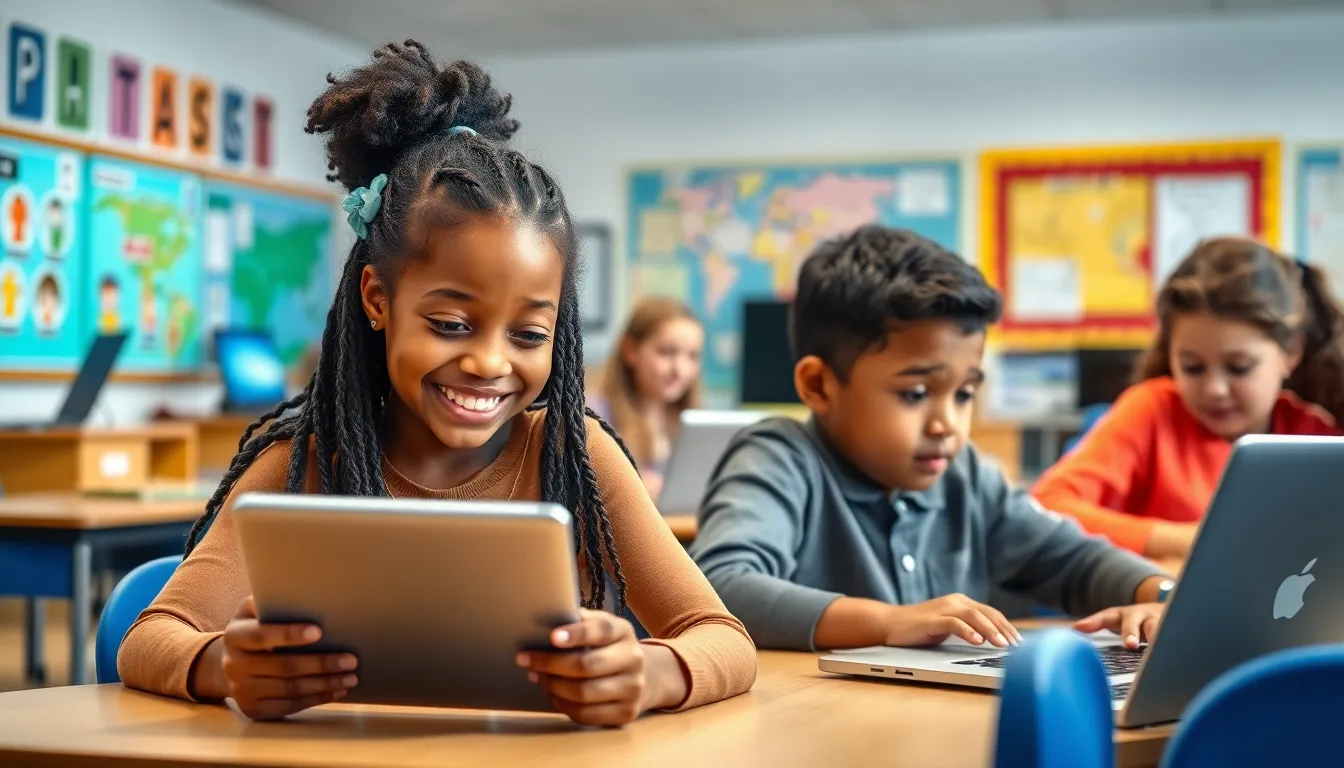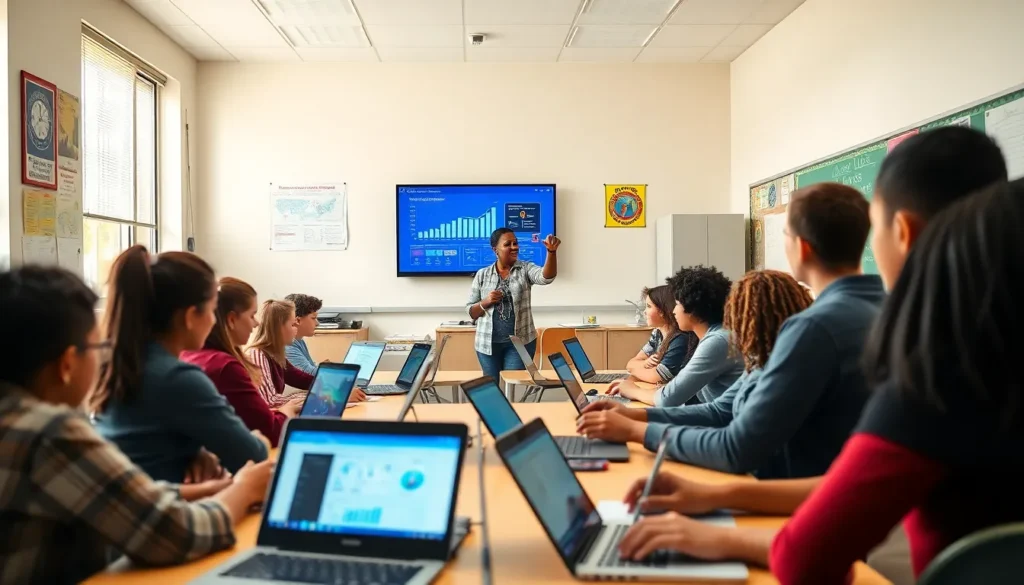In today’s fast-paced world, education technology, or EdTech, is revolutionizing how students learn and teachers instruct. With the rise of digital tools and online platforms, classrooms are transforming into dynamic environments where personalized learning thrives. This shift is not just about using technology; it’s about enhancing educational experiences and outcomes.
As schools and universities embrace innovative solutions, they’re discovering new ways to engage learners and streamline administrative tasks. From interactive apps to virtual classrooms, EdTech is breaking down barriers and making education more accessible than ever. Understanding the impact of these advancements is essential for educators, students, and parents alike as they navigate this evolving landscape.
Table of Contents
ToggleOverview of EdTech
Education technology (EdTech) refers to the integration of digital tools and resources in teaching and learning processes. It encompasses a wide range of technological solutions that enhance educational experiences.
Definition of EdTech
EdTech includes software, hardware, and online platforms designed to facilitate learning. Examples are learning management systems (LMS), virtual classrooms, and educational apps. These technologies cater to diverse learning styles and needs, leading to more effective educational outcomes.
Importance of EdTech in Modern Education
EdTech plays a critical role in modern education by promoting accessibility and engagement.
- EdTech provides personalized learning experiences, allowing students to learn at their own pace.
- EdTech enhances collaboration through interactive tools, enabling real-time communication among students and educators.
- EdTech supports data-driven decision-making by offering insights into student performance and engagement levels.
- EdTech equips educators with innovative methods to deliver instruction, fostering creative teaching approaches.
Understanding EdTech’s importance ensures educators, students, and parents effectively navigate the evolving educational landscape.
Types of EdTech Tools

EdTech encompasses a wide range of tools designed to enhance the learning experience. The following categories highlight key types of EdTech tools.
Learning Management Systems (LMS)
LMS platforms streamline educational administration and facilitate online learning. They centralize course management, track student progress, and offer resources in one accessible location. Popular LMS examples include Blackboard, Moodle, and Google Classroom. These systems enable teachers to create, distribute, and assess learning materials, boosting organizational efficiency and enhancing communication between educators and students.
Educational Apps and Software
Educational apps and software provide interactive experiences that support various subjects and skills. Tools like Quizlet, Duolingo, and Khan Academy cater to different learning preferences, reinforcing concepts through gamification, quizzes, and instructional videos. These resources allow students to learn at their own pace, offering personalized education tailored to individual needs and fostering engagement through interactive features.
Virtual and Augmented Reality in Education
Virtual reality (VR) and augmented reality (AR) technologies create immersive learning environments that enhance engagement and understanding. Schools utilize VR platforms like zSpace and Google Expeditions to transport students to historical sites or scientific laboratories, providing hands-on learning opportunities. AR apps, such as Merge Cube, overlay digital information onto real-world objects, allowing learners to explore complex concepts in a more relatable context. These tools promote experiential learning, enhancing retention and deepening comprehension.
Benefits of EdTech
EdTech offers numerous advantages that enhance the educational landscape. These benefits include improved learning experiences, greater accessibility, and tailored learning paths for students.
Enhanced Learning Experience
EdTech tools create engaging and interactive environments. They incorporate multimedia elements like videos, simulations, and gamified content to facilitate deeper understanding. Students actively participate through online discussions and collaborative projects, fostering critical thinking and creativity. Tools like Kahoot! and Nearpod provide real-time feedback, which enhances engagement and motivates learners.
Accessibility and Inclusivity
EdTech promotes equal access to education for all students. Online platforms break geographical barriers, allowing learners from different locations to access quality resources. Adaptive technologies, including text-to-speech software and captioning services, support students with disabilities, making learning more inclusive. Institutions can implement asynchronous learning strategies, allowing students to learn at their own pace and according to their own schedules.
Personalized Learning Paths
EdTech enables personalized learning experiences tailored to individual student needs. Adaptive learning platforms assess student performance and adjust content difficulty based on their progress. This approach helps identify knowledge gaps and promotes mastery of subjects. Platforms like Khan Academy and iXL provide custom pathways that ensure students remain engaged while achieving academic goals.
Challenges in EdTech Implementation
EdTech implementation faces several challenges that can hinder its effectiveness in enhancing educational experiences. Understanding these obstacles is crucial for successful integration.
Digital Divide
Digital divide presents a significant barrier to effective EdTech implementation. Students from low-income families often lack access to reliable internet connections and devices. According to Pew Research, 14% of American households with school-age children do not have a computer at home. This lack of resources can lead to inequitable learning opportunities. Educational institutions must find solutions, such as providing devices or public access points, to bridge this gap.
Resistance to Change from Educators
Resistance to change from educators can obstruct EdTech progress in schools. Many teachers feel overwhelmed by new technologies, leading to apprehension about integrating these tools into their curricula. A survey conducted by EdTech Magazine indicated that 45% of educators believe they lack adequate training for using educational technology effectively. Providing targeted professional development and ongoing support can help alleviate these concerns, fostering a culture of innovation among educators.
Data Privacy Concerns
Data privacy concerns pose a critical issue in EdTech environments. The collection of student information raises questions about security and confidentiality. In 2021, the Student Privacy 101 report revealed that 68% of parents are worried about how their child’s data is being used. Educational institutions must comply with regulations such as FERPA and COPPA to protect student data. Transparent data management policies and clear communication with parents can help address these issues, ensuring a safer educational landscape.
Future Trends in EdTech
EdTech continues to evolve, driven by advancements in technology and changing educational needs. Key trends shaping the future include artificial intelligence, gamification, and collaborative learning platforms.
Artificial Intelligence in Education
Artificial intelligence (AI) enhances personalized learning experiences by analyzing student data and adapting content to meet individual needs. AI algorithms assess learning styles and performance analytics, enabling educators to tailor lessons effectively. Tools like chatbots offer immediate support, while AI-driven tutoring systems provide additional resources for students. This technology fosters adaptive learning environments, ensuring students receive the right support at the right time.
Gamification of Learning
Gamification incorporates game-design elements into educational settings, increasing student engagement and motivation. By using point systems, badges, and leaderboards, educators create competitive yet fun learning experiences. Platforms like Kahoot! and Classcraft exemplify this trend by transforming traditional assessments into interactive games. Gamification encourages collaboration, critical thinking, and active participation, leading to improved learning outcomes.
Collaborative Learning Platforms
Collaborative learning platforms facilitate teamwork and communication among students, enhancing the educational experience. Tools such as Google Workspace and Microsoft Teams support group projects and allow real-time sharing of resources. These platforms promote peer-to-peer interaction, enabling students to learn from one another while developing essential teamwork skills. By fostering an inclusive environment, collaborative learning platforms encourage diverse perspectives and enhance problem-solving abilities.
The evolution of EdTech is reshaping the educational landscape in profound ways. As digital tools become integral to learning environments, they offer unprecedented opportunities for personalized education and enhanced engagement. Educators and institutions must embrace these innovations while addressing the challenges that accompany them.
By prioritizing training and support for educators, fostering inclusivity, and ensuring data privacy, the full potential of EdTech can be realized. Looking ahead, the integration of AI and gamification will likely continue to drive engagement and effectiveness in learning. As the future unfolds, staying informed and adaptable will be key to maximizing the benefits of education technology.









